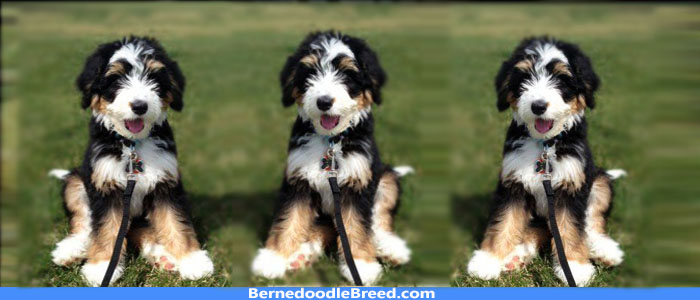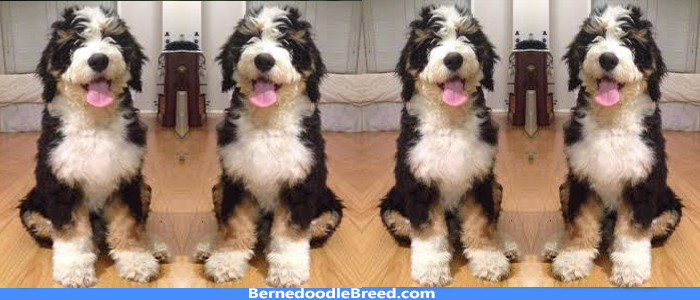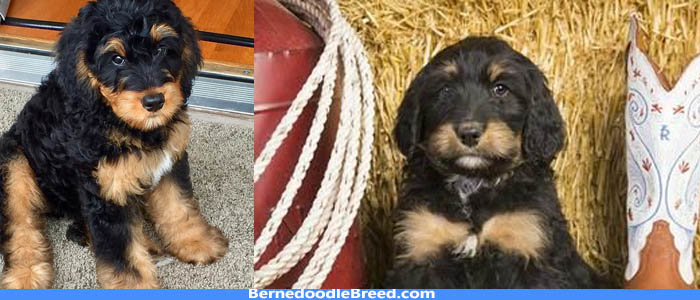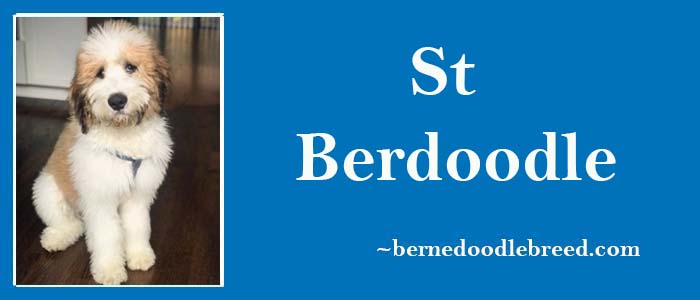What is an Australian Bernedoodle?
The Australian Bernedoodle is a mixed breed dog created by crossing a Bernese Mountain Dog with an Australian Labradoodle. This breed is known for having a hypoallergenic coat and a friendly, outgoing personality. They typically weigh between 50 and 90 pounds and stand between 18 and 29 inches tall at the shoulder.
Australian Bernedoodles are intelligent and easy to train, making them a great choice for families. They’re also known for being affectionate and loyal to their owners. As a mixed breed, they can inherit a variety of traits from their parents, including the wavy or curly coat of the Poodle, the calm temperament of the Bernese Mountain Dog, or the intelligence and trainability of both breeds.
Physical characteristics
Australian Bernedoodles can vary in size depending on the size of their Poodle parent. They are generally medium to large-sized dogs and can weigh anywhere from 50 to 90 pounds (22 to 40 kg). They also stand at a height of 23 to 29 inches (58 to 74 cm) tall at the shoulder.
The life expectancy of an Australian Bernedoodle is between 12 to 15 years, which is similar to that of both the Bernese Mountain Dog and the Poodle. However, it’s important to maintain a healthy diet, regular exercise, and routine veterinary care to ensure a longer and healthier life for your Australian Bernedoodle.
It’s worth noting that while genetics can influence the size and lifespan of an Australian Bernedoodle, other factors such as nutrition, exercise, and overall health can also play a significant role. Therefore, providing your Bernedoodle with proper care and attention can help ensure a happy and healthy life.
Temperament and personality of Australian Bernedoodle
The Australian Bernedoodle is a breed known for its friendly, outgoing, and affectionate temperament, making it an excellent companion for families and individuals. They are intelligent, easy to train, and enjoy spending time with their human family. As a hybrid breed, their personality can be influenced by the traits of the Bernese Mountain Dog and the Australian Labradoodle. Bernese Mountain Dogs are known for their gentle and loyal nature, while Australian Labradoodles are playful and sociable. Therefore, Australian Bernedoodles are a mix of these traits and can adapt to different living situations.
Moreover, Australian Bernedoodles are good with children and other pets and get along well with other dogs. They have a moderate energy level and enjoy indoor and outdoor activities, making them ideal for families with different lifestyles.
Features of Australian Bernedoodle
- Energetic
- Intelligent
- Trainable
- Loving
- Loyal
- Low or No Shed
Health issues of Australian Bernedoodle
Australian Bernedoodles, like all dog breeds, may be susceptible to certain health issues. However, being a hybrid breed, if their parents are healthy, they may have a lower risk of inheriting health issues than their purebred counterparts. Some common health issues that may affect Australian Bernedoodles include hip and elbow dysplasia, which can cause joint pain and mobility issues, eye problems such as cataracts or progressive retinal atrophy (PRA), skin allergies, and ear infections. Additionally, bloat is a serious condition that can occur in large dogs and may cause the stomach to twist and cut off blood flow to the organs.
It’s important to note that not all Australian Bernedoodles will develop these health issues, and responsible breeders will conduct health screenings on their breeding dogs to minimize the risk of inherited health problems. Regular veterinary checkups, proper nutrition, and exercise can also help ensure the health and well-being of your Australian Bernedoodle
Australian Bernedoodle Coat
The Australian Bernedoodle has a unique coat that can vary in texture and appearance depending on the individual dog’s genetics. Their coat is typically wavy or curly, and can range in color from black, white, and brown, to shades of cream and red.
Because the Australian Bernedoodle is a hybrid breed, their coat may inherit traits from both the Bernese Mountain Dog and the Australian Labradoodle. Bernese Mountain Dogs have a thick, double coat that sheds heavily, while Australian Labradoodles have a low-shedding, curly coat. As a result, the coat of the Australian Bernedoodle may be low-shedding and hypoallergenic, making them a good choice for people with allergies.
Regular grooming is important to maintain the health and appearance of an Australian Bernedoodle’s coat. Brushing the coat regularly can help prevent matting and tangles, and may also help distribute the natural oils in the coat, keeping it healthy and shiny. Additionally, trimming the coat regularly can help keep it at a manageable length and prevent it from becoming too long and unruly.
Colors of Australian Bernedoodle
The coat of an Australian Bernedoodle can come in a variety of colors, which can include black, white, brown, cream, and red. The specific color and pattern of an Australian Bernedoodle’s coat can vary depending on the genetics of their parents.
Some Australian Bernedoodles may have a solid color coat, while others may have a combination of two or more colors. Some common coat patterns in Australian Bernedoodles include:
- Tri-Color: This is a classic Bernese Mountain Dog pattern, featuring a black coat with white and brown markings.
- Sable: This is a unique and beautiful coat pattern that features a coat that is a mixture of colors, often including shades of brown, black, and cream.
- Parti-Color: This pattern features a coat that is predominantly white with patches of another color.
- Phantom: This pattern features a coat that is a solid color with distinct markings on the legs, chest, and face.
- Merle: This pattern features a coat with a marbled or speckled appearance, often in shades of blue, gray, and black.
Grooming of Australian Bernedoodle
Australian Bernedoodles have a thick, wavy, or curly coat that needs regular grooming to keep it healthy, free from mats, and tangles. The grooming requirements of Australian Bernedoodles may vary depending on their coat type, but they generally need regular brushing, bathing, and trimming.
Here are some grooming tips for Australian Bernedoodles:
Brushing: Brush your Australian Bernedoodle’s coat at least once a week to prevent mats and tangles. Use a slicker brush or a pin brush, and gently remove any loose fur or detangle any knots.
Bathing: Bathe your Australian Bernedoodle every 6 to 8 weeks or as needed, using a gentle dog shampoo and conditioner to keep their coat clean and shiny.
Trimming: Trim your Australian Bernedoodle’s coat every 8 to 12 weeks to maintain a healthy length and prevent mats. Focus on trimming the hair around their eyes, ears, and paws.
Ear Cleaning: Clean your Australian Bernedoodle’s ears regularly to prevent infections. Use a gentle ear-cleaning solution and a cotton ball to clean the inside of their ears.
Nail trimming: Trim your Australian Bernedoodle’s nails every 4 to 6 weeks to prevent overgrowth and discomfort. Use a sharp pair of dog nail clippers and be careful not to cut the quick.
Regular grooming can help keep your Australian Bernedoodle looking and feeling its best, and can also help you bond with your furry friend.
Exercising and training of Australian Bernedoodle
Australian Bernedoodles are an active and intelligent breed that requires daily exercise and mental stimulation. Here are some tips for exercising and training your Australian Bernedoodle:
- Daily Exercise: Australian Bernedoodles need at least 30 minutes to 1 hour of exercise per day. This can include a brisk walk, a game of fetch, or playtime in a fenced-in yard.
- Mental Stimulation: In addition to physical exercise, Australian Bernedoodles also need mental stimulation to keep them engaged and prevent boredom. This can include training sessions, puzzle toys, and interactive games.
- Training: Australian Bernedoodles are highly trainable and respond well to positive reinforcement training methods. Start training your Australian Bernedoodle as soon as possible to establish good habits and prevent unwanted behaviors.
- Socialization: Socialization is important for Australian Bernedoodles to help them become well-adjusted and friendly with other people and animals. Expose your Australian Bernedoodle to a variety of environments, people, and animals from a young age.
- Consistency: Consistency is key when it comes to training your Australian Bernedoodle. Use the same commands and reward system every time to avoid confusion and ensure your dog knows what is expected of them.
Remember to always provide plenty of positive reinforcement, such as treats, praise, and affection, to encourage good behavior and reinforce the bond between you and your Australian Bernedoodle. You can also buy toys for your Bernedoodle and train them with these toys.
Benefits of Australian Bernedoodle
- Good for Allergies: Australian Bernedoodles are considered hypoallergenic, which means they produce less dander than other breeds. This can be a great benefit for people with allergies or asthma who still want to own a dog.
- Intelligent and Trainable: Australian Bernedoodles are intelligent and eager to please, making them easy to train. They respond well to positive reinforcement and enjoy learning new tricks and commands.
- Loving and Affectionate: Australian Bernedoodles are known for their affectionate and loving nature. They bond closely with their owners and enjoy spending time with their families.
- Active and Energetic: Australian Bernedoodles are an active and energetic breed. They require regular exercise and playtime to keep them physically and mentally stimulated.
- Low-Shedding: Australian Bernedoodles have a low-shedding coat, which means they require less grooming and maintenance than some other breeds.
- Good with Children: Australian Bernedoodles are generally good with children and make great family pets. They are patient and gentle with kids, making them an excellent choice for families with young children.
Is the Australian Bernedoodle good for families?
Yes, the Australian Bernedoodle is generally a good choice for families. They are known for being friendly, affectionate, and outgoing, making them great companions for children and adults alike.
Australian Bernedoodles are also typically good with other pets, including dogs and cats, and can be socialized to get along with other animals. They have a playful and energetic nature that can keep up with active families, but they are also content to cuddle up with their owners and relax.
Additionally, Australian Bernedoodles are known for being intelligent and easy to train, which can be helpful for families who want a well-behaved dog. They are also low-shedding and hypoallergenic, which can be a plus for families with allergies.
Difference Between Male and Female Australian Bernedoodle?
The difference between male and female Australian Bernedoodles is generally similar to that of other dog breeds, but there are a few differences to consider.
Size: Male Australian Bernedoodles are usually larger than females, with a height ranging from 22 to 29 inches and a weight ranging from 60 to 90 pounds. Females, on the other hand, are generally smaller in size, with a height ranging from 18 to 24 inches and a weight ranging from 50 to 70 pounds.
Temperament: Male and female Australian Bernedoodles generally have similar temperaments, but individual personality traits can vary. Some owners report that males can be more independent and less clingy than females, while others report the opposite. It’s important to socialize and train your Australian Bernedoodle regardless of gender to ensure they develop into well-behaved and well-adjusted dogs.
Health: Male and female Australian Bernedoodles can have different health issues, although this is more related to individual breeding lines and genetics than gender. It’s important to choose a reputable breeder who health-tests their breeding dogs and provides proper care for their puppies, regardless of gender.
Reproductive Health: One of the most significant differences between male and female Australian Bernedoodles is their reproductive health. Females will experience heat cycles and may need to be spayed to prevent unwanted litters, while males will need to be neutered to prevent behaviors such as marking and roaming. Spaying and neutering can also provide health benefits and prevent certain reproductive health issues.
Overall, the differences between male and female Australian Bernedoodles are generally similar to those of other dog breeds, but individual personality traits can vary. It’s important to choose a dog based on its individual temperament and needs, rather than just its gender.
F.A.Qs:
Is the Australian Bernedoodle known for its aggressive behavior?
No, the Australian Bernedoodle is typically a friendly and affectionate dog that gets along well with children and other pets. However, it’s important to remember that every dog is an individual and their behavior can be influenced by various factors such as genetics, socialization, and training.
What is the age at which an Australian Bernedoodle is fully grown?
The Australian Bernedoodle is usually considered fully grown between 12-18 months of age, depending on the individual dog and its genetics. As a larger breed, it may take longer to reach full maturity than smaller breeds.
What is the best food to feed an Australian Bernedoodle?
It’s essential to choose a high-quality dog food that meets your Australian Bernedoodle’s nutritional needs. Look for a dog food that lists a protein source (such as chicken, beef, or fish) as the first ingredient and doesn’t contain fillers or artificial preservatives.
Depending on your dog’s age, activity level, and overall health, you may need to choose a specific type of dog food. For example, puppies may require food formulated for growth and development, while senior dogs may benefit from food with lower calories to maintain a healthy weight.
What is the average cost of an Australian Bernedoodle?
The cost of an Australian Bernedoodle can vary depending on factors such as the breeder, location, and the dog’s age and lineage. On average, you can expect to pay anywhere from $2,500 to $5,000 for an Australian Bernedoodle puppy. However, it’s important to do your research and choose a reputable breeder who health-tests their breeding dogs and provides proper care for their puppies.
Overall, the Australian Bernedoodle is a great choice for families with children or other pets. They are generally friendly, low-maintenance dogs that require regular exercise and grooming to keep their coat healthy.










